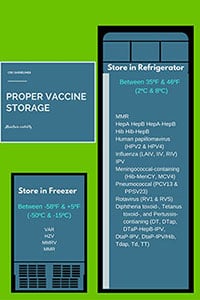
The Center for Disease Control and Prevention (CDC) defines the vaccine cold chain as a temperature-controlled environment used to maintain and distribute vaccines in optimal condition. All vaccines lose potency over time, but how quickly they lose potency is dependent upon temperature. Studies show that many vaccines in developing and developed countries are exposed to improper storage conditions, with some countries completely unable to maintain the cold chain due to freezing during distribution (1).
Proper vaccine storage and handling plays a critical role in protecting communities and individuals from vaccine-preventable diseases. Vaccine quality is a shared responsibility of those involved from the time the vaccine is manufactured to the moment it is administered. The manufacturer is responsible for using dependable storage equipment at the plant as well as properly maintaining vaccine temperatures during transport to the vaccine distribution center. The distribution center is then held accountable for maintaining proper cold storage until the vaccines arrive at the provider facility. At that point, the vaccine provider is in charge of storing the vaccine under appropriate conditions until administration. The following flow chart represents the vaccine cold chain:
Vaccine Cold Chain
The cold chain is crucial to ensuring vaccine potency. Excessive heat, cold, or light can damage vaccines. Every time a vaccine is exposed to inappropriate temperatures or light conditions, it becomes less potent. Eventually, potency will be lost and the vaccines become useless. Refrigerated vaccines should be stored between 35°F and 46°F (2°C and 8°C) and frozen vaccines should be stored between -58°F and +5°F (-50°C and -15°C). All thermometers used for monitoring vaccine storage temperatures should be calibrated and certified by an appropriate agency (e.g.,National Institute of Standards and Technology) (4).
 |
|
See infographic about CDC Guidelines for Maintaining Vaccine Viability |
Freezing Temperatures
Freezing temperatures can irreversibly reduce the potency of vaccines that are required to be refrigerated. Liquid vaccines that contain aluminum salt adjuvants are extremely sensitive to freezing temperatures. Additional non-adjuvanted vaccines, such as poliovirus and some influenza vaccines are also at high risk when exposed to freezing temperatures (2). It is almost impossible to identify by physical examination that vaccines were not stored under appropriate conditions making it extremely important that vaccine refrigerators maintain proper temperature and that monitoring procedures are in place.
Heat Sensitivity
Effects of the storage environment being too warm are often more gradual, predictable, and smaller in magnitude than losses of potency due to freezing, however, all vaccines are heat-sensitive (3). Certain vaccines such as, MMR, IPV, BCG, LAIV and varicella, are more sensitive to heat than others. Varicella vaccine is highly heat sensitive and must always be stored in a frozen state. MMR, BCG and varicella become even more susceptible to heat when reconstituted (4). Once again, dependable storage and a highly trained staff will ensure that vaccines are not being exposed to heat.
Subpotent vaccines come at a cost, not only for those financially responsible, but also for the beneficiaries who may not be protected from disease. Maintaining the cold chain requires well trained personnel, reliable transportation, highly dependable storage equipment, and efficient and effective management procedures.
References:
(1) Matthias DM, Robertson J, Garrison MM, et al. Freezing temperatures in the vaccine cold chain: a systematic literature review. Vaccine.2007;25(20):3980–3986.
(2) http://sites.path.org/vpfst/product-stability/freeze-protection/
(3) http://www.cdc.gov/mmwr/preview/mmwrhtml/mm5242a6.htm
(4) http://www.immune.org.nz/sites/default/files/factsheets/MoH,%20vaccine-storage-guidelines,%202012.pdf



